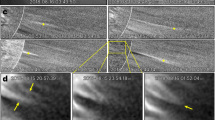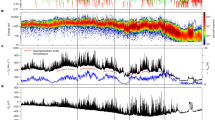Abstract
The discovery of coronal loops has provoked major revisions in the theory of solar and stellar atmospheres. The solar corona is now recognized as a highly structured plasma, organized by bundles of intense magnetic field into individual arch- and loop-like structures along which gas can flow1. Each arch, rooted in the solar interior, extends through the chromosphere (T<104 Κ), and generally contains coronal plasma (T>106Κ) in its upper reaches. Early attempts at explaining the temperature and density structure of isolated static loops met with considerable success, despite the simplicity of the theory2,3; however, attempts to generalize the theory to describe loops with mass flows have remained singularly unsuccessful4–9. Here we point out that the puzzling observational properties of loop mass flows10–15 can be naturally explained if the loop is sufficiently cool (T ≲ 106 K)—that is, if it contains no coronal plasma.
This is a preview of subscription content, access via your institution
Access options
Subscribe to this journal
Receive 51 print issues and online access
$199.00 per year
only $3.90 per issue
Buy this article
- Purchase on Springer Link
- Instant access to full article PDF
Prices may be subject to local taxes which are calculated during checkout
Similar content being viewed by others
References
Withbroe, G. L. in Solar Active Regions (ed Orrall, F. Q.) 199–212 (Colorado Associated University Press, Boulder, 1980).
Craig, I. J. D., McClymont, A. N. & Underwood, J. H. Astr. Astrophys. 70, 1–11 (1978).
Rosner, R., Tucker, W. H. & Vaiana, G. S. Astrophys. J. 220, 643–655 (1978).
Yeh, T. Sol. Phys. 55, 241–250 (1977).
Pneuman, G. W. & Kopp, R. A. Sol. Phys. 57, 49–64 (1978).
Cargill, P. J. & Priest, E. R. Sol. Phys. 65, 251–269 (1980).
Athay, R. G. Astrophys. J. 249, 340–348 (1981).
Noci, G. Sol. Phys. 69, 63–76 (1981).
Craig, I. J. D. & McClymont, A. N. Astrophys. J. 307, 367–380 (1986).
Gebbie, K. B. et al. Astrophys. J. 251, L115–L118 (1981).
Feldman, U., Cohen, L. & Doschek, G. A. Astrophys. J. 255, 325–328 (1982).
Dere, K. P. Sol. Phys. 77, 77–93 (1982).
Doschek, G. A., Feldman, U. & Bohlin, J. D. Astrophys. J. 205, L177–L180 (1976).
Lites, B. W. et al. 210, L111–L113 (1976).
Athay, R. G., Gurman, J. B., Henze, W. & Shine, R. A. Astrophys. J. 265, 519–529 (1983).
Boris, J. P. & Mariska, J. T. Astrophys. J. 258, L49–L52 (1982).
Mariska, J. T. & Boris, J. P. Astrophys. J. 267, 409–420 (1983).
McClymont, A. N. & Craig, I. J. D. Astrophys. J. (in the press).
Author information
Authors and Affiliations
Rights and permissions
About this article
Cite this article
McClymont, A., Craig, I. An explanation for fast downflows on the Sun. Nature 324, 128–129 (1986). https://doi.org/10.1038/324128a0
Received:
Accepted:
Issue Date:
DOI: https://doi.org/10.1038/324128a0
This article is cited by
-
Downflows in coronal loops
Nature (1987)
Comments
By submitting a comment you agree to abide by our Terms and Community Guidelines. If you find something abusive or that does not comply with our terms or guidelines please flag it as inappropriate.



